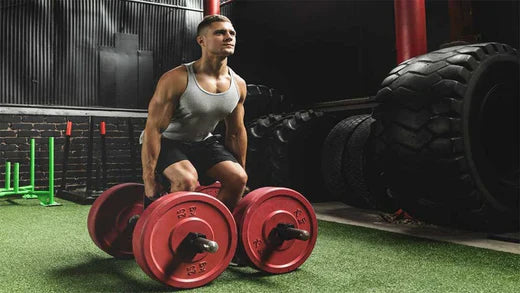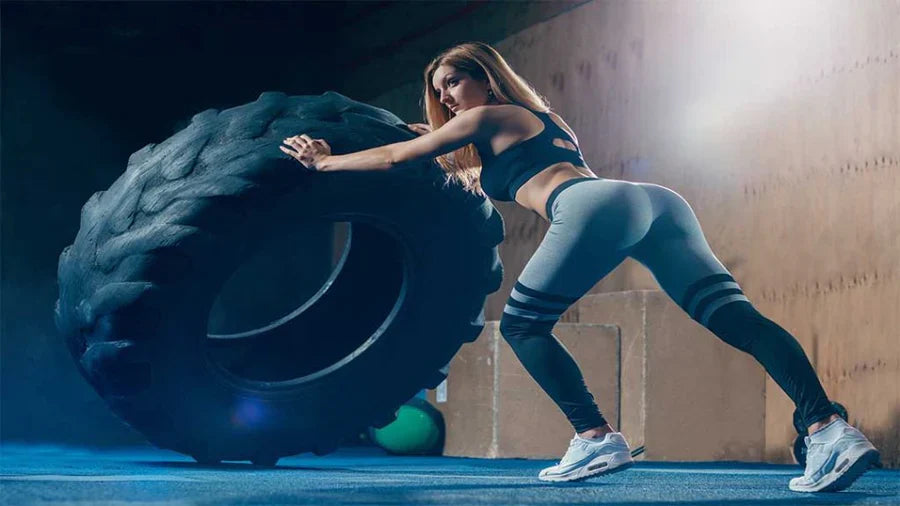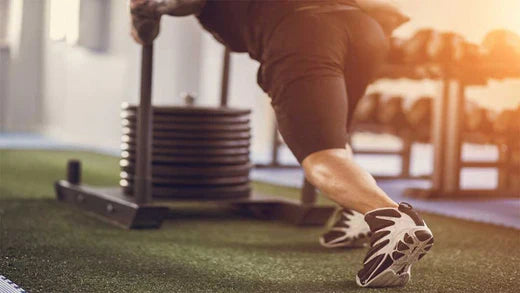5 façons d'améliorer vos entraînements d'homme fort

Briser les barrières de l'entraînement des hommes forts
Vous avez récemment commencé un entraînement de Strongman ? Vous pratiquez le Strongman depuis longtemps et vous avez atteint un point critique ?
Que vous soyez débutant ou que vous ayez atteint votre plateau de force, il existe des moyens simples de briser le moule pour vous assurer de continuer à devenir plus fort et plus rapide.
Passons en revue cinq méthodes pour améliorer vos entraînements Strongman, en commençant par l'échauffement et en passant par les techniques d'entraînement. Nous examinerons également les meilleurs équipements pour cet entraînement.
ÉCHAUFFEMENT DES MUSCLES OPPOSÉS
Il n'est pas surprenant que vous ayez besoin d'échauffer les groupes musculaires qui seront les plus sollicités. Par exemple, si vous vous apprêtez à effectuer un rowing à la barre à plus de 85 % de votre capacité maximale sur une répétition, commencez par vous échauffer avec deux séries d'exercices à faible intensité.
Si vous vous concentrez uniquement sur le groupe musculaire qui est sur le point de vous écraser, vous manquez une excellente occasion d'augmenter vos performances.
Nous vous recommandons d'effectuer une série d'échauffement léger sur le groupe musculaire opposé, car cela peut vous aider à gagner en force lors de votre série principale. Dans l'exemple ci-dessus, votre objectif est un rowing avec barre lourde. Avant cela, effectuez une série très légère de pompes ou de développés pectoraux avec haltères. Ne considérez pas cela comme une série de travail ; utilisez 40 % à 50 % de votre 1RM et limitez le nombre de répétitions à 10 ou moins.
Équipez-vous avec le bon équipement
Tout comme en powerlifting, il y a un moment où vous atteindrez le maximum de votre puissance brute et de vos performances. À terme, vous devrez utiliser quelques équipements de fitness pour continuer à progresser.
Ou peut-être avez-vous arrêté de pratiquer le Strongman depuis des années ? L'âge a commencé à vous rattraper et vous avez besoin d'un coup de pouce pour assurer une bonne technique, une bonne exécution et des résultats satisfaisants. Quelle que soit votre raison, voici quelques équipements de Strongman que nous vous recommandons d'avoir dans votre arsenal :
Ceinture de puissance : ce n'est pas votre ceinture d'haltérophilie typique, une ceinture de puissance de qualité élite est dotée d'un levier en acier robuste pour assurer une compression et un soutien optimaux.
Alpha Grips : L'un des meilleurs moyens d'augmenter votre force de préhension est de s'entraîner avec une barre épaisse. Cependant, si vous n'êtes pas dans une salle de sport qui en propose, vous pouvez utiliser des Alpha Grips. Enroulez-les autour de n'importe quelle barre, haltère ou kettlebell pour augmenter votre force de préhension.
Genouillères : Si vous chargez une barre pour des squats ou des soulevés de terre, vous pouvez envisager d'utiliser des genouillères. Elles vous offrent un soutien et une protection lorsque vous soulevez des charges proches de votre maximum par répétition.
Sangles de levage : Même les personnes dotées d'une force de préhension exceptionnelle peuvent constater que la barre glisse lorsqu'elle est suffisamment chargée. Les sangles de levage vous permettent de concentrer le muscle jusqu'à l'échec ; fini les arrêts brusques à cause de votre prise.
Traîneau motorisé : Qui ne rêve pas d'un semi-remorque à tirer ? Puisque votre jardin ou votre salle de sport n'est pas assez grand pour accueillir un camion géant, le plus réaliste est un traîneau motorisé. Chargez-le et faites comme si vous tiriez ce camion.
ESSAYEZ L'ENTRAÎNEMENT NÉGATIF
Si vous voulez vraiment voir votre force monter en flèche, trouvez deux partenaires de musculation et essayez l’entraînement négatif.
C'est là que vous utilisez 150 à 200 % de votre maximum par répétition. Par exemple, si vous ne pouvez soulever 90 kg au développé couché qu'une seule fois avec une posture parfaite, c'est votre 1RM. Avec un entraînement négatif, vous soulèveriez 136 à 180 kg avec assistance.
Avec l'entraînement négatif, vous dépassez votre 1RM et vous vous concentrez sur la partie excentrique ou négative du mouvement. Qu'est-ce que cela signifie ? Chaque exercice comporte trois phases :
Concentrique : il s'agit de soulever le poids. Par exemple, lors d'un curl biceps, la partie concentrique du mouvement consiste à amener l'haltère vers l'épaule.
Isométrique : il s'agit de la pause du mouvement. Dans l'exemple ci-dessus, une fois que l'haltère atteint votre épaule, marquez une pause pour contracter le muscle.
Excentrique : Il s'agit de l'abaissement du poids. Pour reprendre l'exemple, lorsque vous abaissez l'haltère de votre épaule à la position de départ, il s'agit de la partie excentrique.
L'entraînement négatif met l'accent sur la partie excentrique ou descendante du mouvement, une méthode éprouvée pour augmenter considérablement la force. En effet, la tension et l'activation musculaire sont bien plus importantes pendant la partie excentrique que pendant la partie concentrique.
Une activation musculaire accrue se traduira par une meilleure force et de meilleures performances. Veillez simplement à vous accorder suffisamment de temps de repos pour prévenir les blessures sportives , car cette méthode peut abîmer les tissus conjonctifs.
AUGMENTER L'INTENSITÉ AVEC DES BANDES DE RÉSISTANCE
Pour poursuivre sur le point précédent, une autre excellente façon de souligner la partie excentrique d'un exercice sans utiliser une charge excessive est d'utiliser des bandes de résistance. Écoutez-nous :
Les bandes de résistance ont la particularité de se tendre davantage. De plus, elles offrent un niveau de tension constant, notamment lors de la descente du poids. En attachant des bandes de résistance à la barre ou à l'haltère, l'exercice devient plus intense à mesure que vous soulevez le poids, la tension atteignant son maximum lors de la partie isométrique.
À mesure que vous abaissez le poids, la tension reste élevée, forçant une plus grande activation musculaire. Pas mal pour un élastique, non ?
UTILISEZ LA PLYOMÉTRIE
La pliométrie est un excellent moyen d'augmenter la puissance brute. Plus communément appelée entraînement par sauts, cette forme d'entraînement ne nécessite aucun poids supplémentaire. Vous utiliserez le poids du corps et la force pure pour réaliser les exercices. Un jour par semaine, utilisez les exercices suivants à la place d'un entraînement cardio :
- Pompes pliométriques : 10
- Squat sauté : 15
- Lancer de balle murale : 10
- Fente sautée : 15
- Burpees BOSU : 10
- Sprints : 15 secondes


